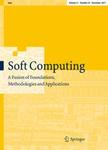版权所有:内蒙古大学图书馆 技术提供:维普资讯• 智图
内蒙古自治区呼和浩特市赛罕区大学西街235号 邮编: 010021

作者机构:Fujian Univ Technol Fujian Prov Key Lab Big Data Min & Applicat Fuzhou 350118 Fujian Peoples R China Fujian Univ Technol Intelligent Informat Proc Res Ctr Fuzhou 350118 Fujian Peoples R China Fujian Univ Technol Sch Comp Sci & Math Fuzhou 350118 Fujian Peoples R China Guilin Univ Elect Technol Guangxi Key Lab Automat Detecting Technol & Instr Guilin 541004 Guangxi Peoples R China Swinburne Univ Technol Dept Comp Sci & Software Engn John St Hawthorn Vic 3122 Australia Zhoukou Normal Univ Sch Network Engn Zhoukou 466001 Henan Peoples R China
出 版 物:《SOFT COMPUTING》 (Soft Comput.)
年 卷 期:2021年第25卷第18期
页 面:12227-12240页
核心收录:
学科分类:08[工学] 0812[工学-计算机科学与技术(可授工学、理学学位)]
基 金:Natural Science Foundation of Fujian Province [2020J01875] Guangxi Key Laboratory of Automatic Detecting Technology and Instruments [YQ20206] National Natural Science Foundation of China [61773415, 61801527, 61103143]
主 题:Sensor ontology matching Multi-objective evolutionary algorithm Inverse modeling
摘 要:To address the heterogeneity problem of sensor data, it is necessary to conduct the Sensor Ontology Matching (SOM) process to find the mappings among diverse sensor data with the same semantics connotation. Currently, many Multi-Objective Evolutionary Algorithms (MOEAs) have been used to match the ontologies, which aim at finding a set of solutions called Pareto Set (PS) in the Pareto Front (PF) to represent a set of trade-off proposals for different Decision Makers (DMs). Being inspired by the success of MOEA with Inverse Model (IM-MOEA) in solving complicated optimization problems, in this work, an Improved IM-MOEA (I-IM-MOEA)-based matching technique is further proposed to enhance the algorithm s matching efficiency as well as the alignment s quality. To overcome the drawback of IM-MOEA that has poor performance on irregular PF, an adjusted selection mechanism is employed to avert the massive reduction in non-domination solutions on irregular PF, a dynamic Reference Vectors (RVs) is used to decrease the computational resources and boost the efficiency of the algorithm, and a local search strategy is introduced to promote the results quality. The experiment employs the benchmark provided by Ontology Alignment Evaluation Initiative (OAEI) and three sensor ontologies to assess the performance of I-IM-MOEA, and the experimental results show that I-IM-MOEA is both effective and efficient.